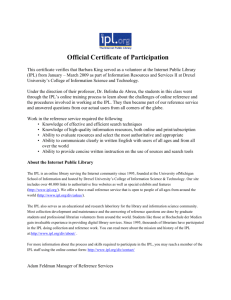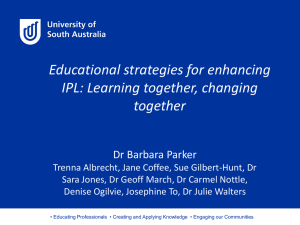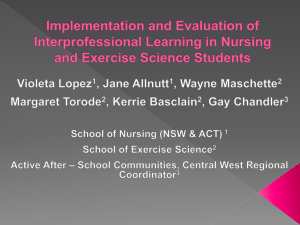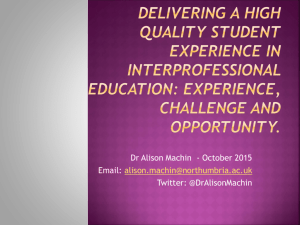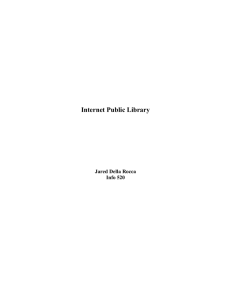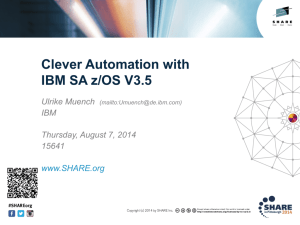Interprofessional Learning - The Essential Handbook for GP
advertisement
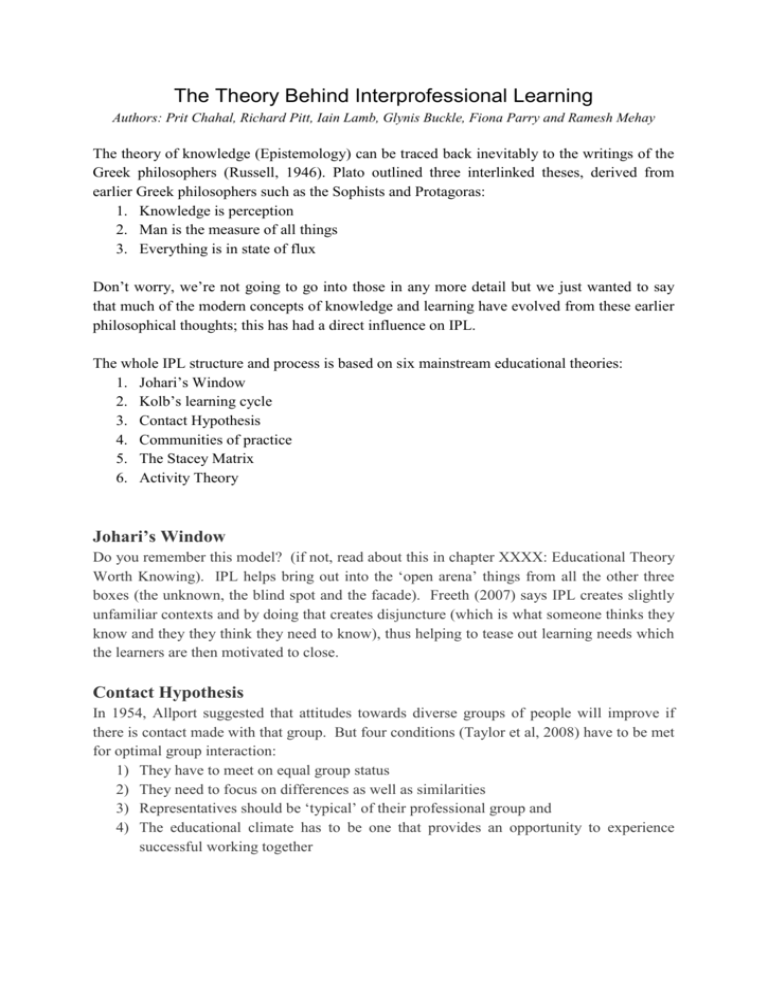
The Theory Behind Interprofessional Learning Authors: Prit Chahal, Richard Pitt, Iain Lamb, Glynis Buckle, Fiona Parry and Ramesh Mehay The theory of knowledge (Epistemology) can be traced back inevitably to the writings of the Greek philosophers (Russell, 1946). Plato outlined three interlinked theses, derived from earlier Greek philosophers such as the Sophists and Protagoras: 1. Knowledge is perception 2. Man is the measure of all things 3. Everything is in state of flux Don’t worry, we’re not going to go into those in any more detail but we just wanted to say that much of the modern concepts of knowledge and learning have evolved from these earlier philosophical thoughts; this has had a direct influence on IPL. The whole IPL structure and process is based on six mainstream educational theories: 1. Johari’s Window 2. Kolb’s learning cycle 3. Contact Hypothesis 4. Communities of practice 5. The Stacey Matrix 6. Activity Theory Johari’s Window Do you remember this model? (if not, read about this in chapter XXXX: Educational Theory Worth Knowing). IPL helps bring out into the ‘open arena’ things from all the other three boxes (the unknown, the blind spot and the facade). Freeth (2007) says IPL creates slightly unfamiliar contexts and by doing that creates disjuncture (which is what someone thinks they know and they they think they need to know), thus helping to tease out learning needs which the learners are then motivated to close. Contact Hypothesis In 1954, Allport suggested that attitudes towards diverse groups of people will improve if there is contact made with that group. But four conditions (Taylor et al, 2008) have to be met for optimal group interaction: 1) They have to meet on equal group status 2) They need to focus on differences as well as similarities 3) Representatives should be ‘typical’ of their professional group and 4) The educational climate has to be one that provides an opportunity to experience successful working together Kolb’s Learning Cycle IPL gets its members to reflect on the experience they’ve been through so far (which is the essence of Kolb’s learning cycle). This reflection will encourage people to conceptualise new ways of doing things (abstract concepts and generalisations) which will hopefully be then put into practice (experimenting). This process is mapped out below; the role of the IPL facilitator is to guide members through this learning cycle. Communities of Practice Wenger examined the consequences of various team cultures 'colliding' in his 'communities of practice'. These are defined as 'groups of people who share a concern or a passion for something they do and learn how to do it better as they interact regularly'. Within their own discipline or communities, members rarely have to justify or explain the concepts or drivers behind their behaviour or actions. However in multidisciplinary teams the potential for conflict and misunderstanding arise at these conceptual organisational boundaries. Wenger argues that at this interface all areas of knowledge should be made explicit and that a shared language and understanding has to evolve for interdisciplinary teams to work effectively. The Stacey Matrix Stacey Matrix tool is helpful in understanding what’s happening in a situation by focusing on the dynamics at the boundaries between learner groups. The matrix is a graph in which the X and Y axes represent decreasing degrees of certainty and agreement respectively. Thus the zero coordinates represents maximum agreement and certainty and is described as the simple zone, whilst the opposite coordinates of minimum agreement and certainty is the zone of chaos. In between these extremes is a large area referred to as the complex zone: Thus in applying this model to multiprofessional teams, it can be envisaged that some multiprofessional organisations may be close to chaos, being both far from agreement and certainty between professional groups and individuals. Leadership with shared vision and interprofessional understanding and empathy could move such an organisation closer to the simple zone of rational and / or political decision making. In moving from the borders of chaos, through the larger area of the complex zone towards the simple zone, the potential for creativity and remodelling is high, with the formation of a healthier and more appropriately aligned team or organisation. Activity Theory (Engestrom) Activity Theory (AT) looks at how organisations interact in creating and exchanging knowledge. It says that conflict and misunderstanding are an inevitable consequence of redefining and redistributing tasks within evolving organisational structures and teams. It suggests conflict can be reduced by open expression by team members of their differences in ideas, concerns and expectations both individually and between their respective organisations. This shouldn’t be that much of a surprise to you (re: the various models of the doctor-patient consultation?). Activity Theory defines the dynamic relationship between the progressive levels of activity, actions and operations: i. Activity is defined as a conscious action and can be a chain of actions. ii. Actions are of chains of operations. iii. Operations, which are conscious actions at first, become more automatic with absorption and practice as they then require conscious effort. This block of text may confuse some of you – but don’t worry. Just read it through and then we’ll discuss it in the context of IPL which should make things clearer. The progression from activity to progressions can be reversed. The unit of analysis in AT is the 'activity system’ which is a flexible unit of analysis or a theoretical lens that can focus in different directions and with variable levels of “magnification” to solve problem (Russel 2002). Such activity could be performed by an individual or team assisted by pre-existing linguistic or cultural tools which can however change and adapt. This is most likely to happen when groups share activity and learn and develop together over a period of time. IPL and Activity Theory Model Application The AT model below could be used to examine IPL activity. For example choosing a broad topic such as patient safety, and aiming towards a common outcome: The ‘Activity’ achieve the ‘Objects’ that help meet the ‘Outcome’ and this could be mapped along the lines of the knowledge, skills and attitudes required to make the outcome possible. The ‘Subject’ is the individual within the ‘Community’ or learning group or team, and part of learning together will be the shared understanding through learning with, from and about different professional colleagues. Additionally, part of the understanding will also relate to the ‘Division of effort’ between the different subjects and how that is decided. For the activity to be successful there will need to be explicit sharing and understanding of ‘Artefacts” and ‘Rules’. Artifacts are the tools, ideas, guidelines and evidence that underpin discussion and learning and ‘Rules’ may be the principles underlying good healthcare but also the guides and information about how each professional group should perform their jobs. There also might be rules about the requirements of each group to maintain their professional development. In IPL it is important to recognize that rules might be different between professional groups and common ground will need to be explored if shared outcomes are to be achieved. Summary IPL is based on sound educational theory, but we’re not going to bore you with all the details. For those of you who are interested in reading more, there are documents on our website that do this. Also, consider reading Chapter XXXX: Educational Theory that Matters. Here’s a quick summary of how IPL relates to the various educational models and theories: Johari’s Window: IPL helps bring out into the ‘open arena’ things from all the other three boxes (the unknown, the blind spot and the facade). Kolb’s learning cycle: The IPL facilitative process is based on the four phases of Kolb’s learning cycle: concrete experience reflective observation abstract conceptualisation active experimentation. Contact Hypothesis: In 1954, Allport suggested that attitudes towards diverse groups of people will improve if there is contact made with that group. Communities of practice: The ‘educational environment’ of groups involved in IPL should be open and comfortable to enable a shared language and understanding to evolve for interdisciplinary teams to work effectively. Stacey Matrix: It can be envisaged that some multiprofessional organisations may be close to chaos, because there is a lack of agreement and certainty between professional groups and individuals. Leadership with shared vision and interprofessional understanding and empathy could move such an organisation closer to the simple zone of rational and/or political decision making (where the potential for creativity and remodelling is high). Activity Theory: Conflict between groups can be reduced by open expression by team members of their differences in ideas, concerns and expectations both individually and between their respective organisations


